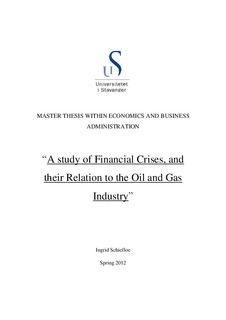| dc.contributor.author | Schiefloe, Ingrid | |
| dc.date.accessioned | 2012-11-01T10:05:03Z | |
| dc.date.available | 2012-11-01T10:05:03Z | |
| dc.date.issued | 2012 | |
| dc.identifier.uri | http://hdl.handle.net/11250/183885 | |
| dc.description | Master's thesis in Economic analysis | no_NO |
| dc.description.abstract | This thesis investigates the relationship between the main oil indicators and the probability of a financial crisis. The main oil indicators include oil consumption, oil production and oil price. The financial probability is based on Carmen Reinhart’s BCDI+ index, which is a financial turbulence index, and Robert Barro’s definition of crises based on a cumulative decline in GDP and ‘Consumption’.
The methodology used in order to establish a quantitative relationship between the main oil indicators and the probability of a financial crisis is: Poisson regression and Logistic regression. As to the current knowledge, this methodology has not been used before.
The first section is a qualitative analysis of the issue, starting with an introduction of financial crises over the last century and the history of the oil and gas industry, subsequently moving on to James Hamilton’s (1983) analysis of its relation to the economy. The section continues with an introduction to Carmen Reinhart’s theory and data from the book ‘This Times is Different: Eight Centuries of Financial Folly’ where the BCDI+ index is explained. The section ends with an examination of Robert Barro’s working paper ‘Macroeconomic Crises since 1870’ where he uses a cumulative decline in ‘Consumption’ and GDP to identify crises.
The second section uses a quantitative approach to further analyze and justify the issue in concern. This section starts with an overview of data and methodology, where some basic descriptive statistics, in addition to a contingency table, are included for each variable. The aim of including this part was to assess the data’s reliability and validity and get a basic indication of whether or not the data point out any crises. After this, a correlation analysis of the variables is performed. The final and most important part of the quantitative analyses includes various logistic regressions and Poisson regressions.
The thesis ends with a conclusion which presents the findings from the quantitative analyses, performed to reveal the relationship between the probability of a financial crisis and the main oil indicators. Oil consumption and oil production were excluded from the regressions because of inadequate data. The analysis gave some ambiguous results in how an increase in the oil price increases the probability of a financial crisis. Three possible explanations for these ambiguous results are the volatility of the oil price, the behavior of the oil price during the crises defined with a binary variable equal to ‘one’ in the regressions, and the position of oil price in the global economy. | no_NO |
| dc.language.iso | eng | no_NO |
| dc.publisher | University of Stavanger, Norway | no_NO |
| dc.relation.ispartofseries | Masteroppgave/UIS-SV-HH/2012; | |
| dc.subject | økonomi | no_NO |
| dc.subject | administrasjon | no_NO |
| dc.subject | økonomisk analyse | no_NO |
| dc.title | A study of financial crises, and their relation to the oil and gas industry | no_NO |
| dc.type | Master thesis | no_NO |
| dc.subject.nsi | VDP::Social science: 200::Economics: 210 | no_NO |
